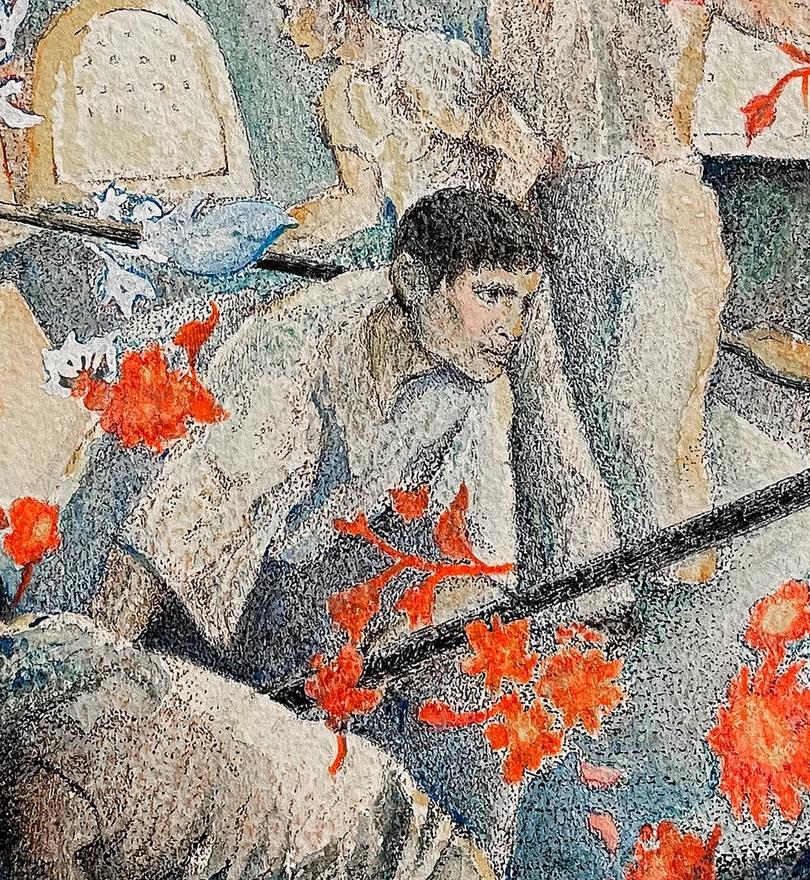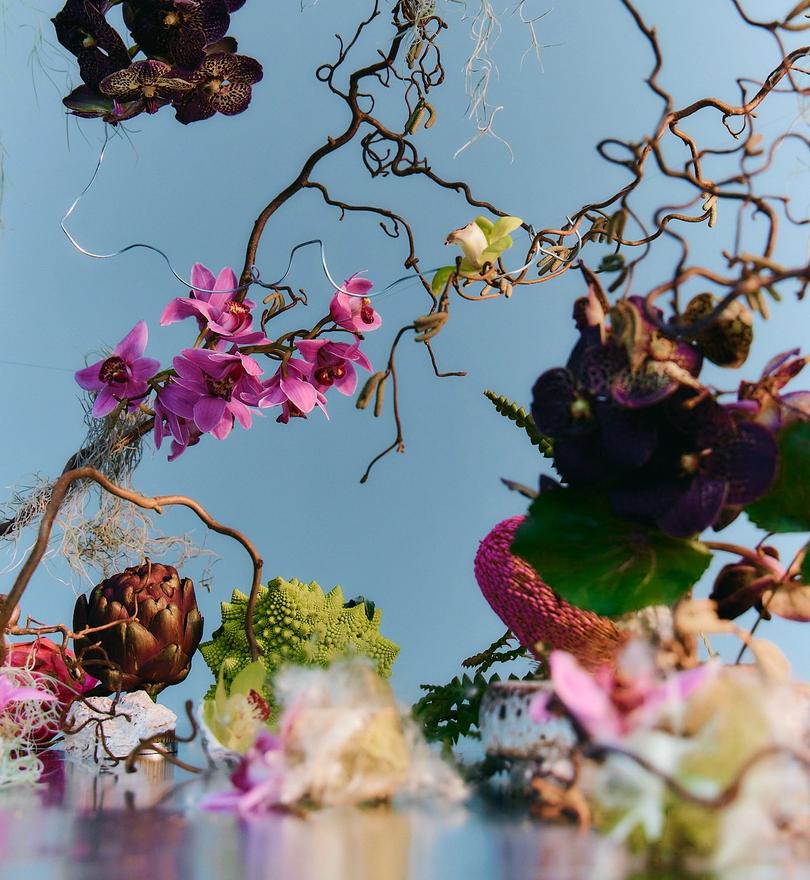The sixth and final instalment in a disorderly A to Z of Aotearoa Asian art. Revisit the previous issues to journey through the full alphabet!
W is for WASIAN

‘We do see elements of the #wasian trend on TikTok as potential social media poetry (working through emotions, questioning and affirming identities, creating loving interest in others) but it is also important to be clear how the trend is shaped by the neoliberal capitalistic aspects of the app itself as well as how its users understand their content and connections to each other.’
— Rebecca Chiyoko King-O’Riain, ‘#Wasian check: Remixing “Asian + White” multiraciality on TikTok’, Genealogy, vol.6, no. 2, June 2022, p. 55

Screenshot of Ersha Island's Instagram profile, January 2025
‘The final screening of the Metro feature-release, “The Red Lantern” with all its beauty of setting and usualness of theme, takes place in the Grand Opera House to-night. Nazimova, in the chief roles (she plays a dual character), sustains most of the interest as Mahlee, the Eurasian, who finds the “yellow” in her blood too much of a handicap, though she tries to believe in the Christianity taught by her friends at the Mission. The cast is an exceptional one, and the dressing and mounting are extravagant but most effective.’
— Evening Post, vol. XCIX, no. 121, 22 May 1920, p. 9

Jennifer Cheuk, call for submissions for the book that would become Everything That Moves, Moves Through Another: An anthology from mixed heritage creatives in Aotearoa, pasted up in Ōtepoti, 2023
X is for XENOPHOBIA
‘The mixed feelings of uncertainty and alienation felt towards Asians today is not so different from the xenophobia of white New Zealand in yesteryears. … The need to better understand our national psyche has been highlighted by the increase in race-related incidents against Asian immigrants, and by the periodic exploitation (especially in election years) of popular fear and insecurity by unscrupulous politicians.’
— Manying Ip and Nigel Murphy, Aliens at My Table: Asians as New Zealanders see them, Penguin Books, Auckland, 2005, p. 8

‘Rather than suggesting that Pākehā racism was the sole cause of the marginalisation of Asia and Asians in the national imaginary — a common argument — this chapter argues that the exclusion of Asians was in fact central to the project of nation-building from the late nineteenth century.’
— Tony Ballantyne, Webs of Empire: Locating New Zealand’s colonial past, Bridget Williams Books, Wellington, 2012, p. 16

Racist graffiti on community noticeboard, Upper Hutt, 1 May 2020. Museum of New Zealand Te Papa Tongarewa (O.048937)
‘A very different pattern emerged when our research project shifted focus to the cities. … The results show that the tension between the two communities was quite apparent while meaningful personal interactions were rare. Much of what the Chinese feel about Māori, and vice versa, is unflattering and some of these critical opinions seem to be based on negative stereotypes current in the public media.’
— Manying Ip, ‘Chinese perceptions of Māori: The “important other”’, in The Dragon & The Taniwha: Māori & Chinese in New Zealand, Auckland University Press, Auckland, 2009, p. 157
‘Unlike ethnic and immigrant minorities who are voluntarily looking to settle down and fit in within the existing social and political framework, Indigenous peoples constitute forcibly incorporated nations who want to “get out” of imposed political arrangements that deny, exclude and oppress.’
— Augie Fleras and Roger Maaka, ‘Indigeneity-grounded analysis (IGA) as policy(-making) lens: New Zealand models, Canadian realities’, The International Indigenous Policy Journal, vol. 1, 2010, p. 15
Y is for YOGA
‘How do we reconcile the contradiction between “Modi the yogi” who proposes to unify the country through yoga and “Modi the Hindu nationalist” who has been actively responsible for dividing it along sectarian lines? What is the function of International Yoga Day within the broader context of Modi’s anti-Muslim politics, both past and present? Why has yoga, in particular, become a central tenet of Modi’s Hindu nationalist agenda?’
— Anusha Lakshmi, ‘Choreographing tolerance: Narendra Modi, Hindu Nationalism, and International Yoga Day’, Race and Yoga, vol.5, no. 1, 2020

Swami Vivekananda (seated with turban) poses with other guests at Green Acre in Maine, circa 1894. Vivekananda was a key figure in the introduction of Vedanta and Yoga to the Western world and he travelled widely, including tours of the UK and the US. Eliot Baha'i Archives, Maine Memory Network
‘This is not a “how to” book — there are already more than enough of those — but a “how come?” one. How come a time-honoured road to enlightenment has turned into a $25 billion-a-year wellness industry? What were the historical twists and social turns on the winding path that led from the caves and forests of ancient India to the gyms, studios and village halls of the modern West? What have the original teachings of the sages lost, or perhaps gained, while being transplanted onto foreign soil? And how is it that there are so many very different forms of yoga, which between them seem to include everything from muscles to mindfulness, stress-busting to spiritual liberation?’
— Alistair Shearer, The Story of Yoga: From ancient India to the modern West, Hurst Publishers, London, 2020, p. 1

Ruth St. Denis and her Denishawn dancers in 'yoga meditation', 1915. New York Public Library Digital Collections (b21043974)

‘My criticism is directed solely against the application of yoga to the peoples of the West. The Spiritual development of the West has been along entirely different lines from that of the East and has therefore produced conditions which are the most unfavourable soil one can think of for the application of yoga. Western civilisation is scarcely a thousand years old and must first of all free itself from its barbarous one-sidedness. This means, above all, deeper insight into the nature of man. But no insight is gained by repressing and controlling the unconscious, and least of all by imitating methods which have grown up under totally different psychological conditions. In the course of the centuries the West will produce its own yoga.’
— CG Jung, ‘Yoga and the West’, in Collected Works, Routledge Kegan Paul, London, 1969

Z is for ZANY
‘I’ve got a more specific reading of post-Fordist or contemporary zaniness, which is that it is an aesthetic explicitly about the politically ambiguous convergence of cultural and occupational performance, or playing and laboring … This explains why this ludic aesthetic has a noticeably unfun or stressed-out layer to it. Contemporary zaniness is not just an aesthetic about play but about work, and also about precarity, which is why the threat of injury is always hovering about it.’
— Sianne Ngai, ‘Our aesthetic categories: An interview with Sianne Ngai’, Cabinet Magazine, Fall 2011

Promo image for Friday Night Bites, 2016. Created by Roseanne Liang, Perlina Lau, Ally Xue and JJ Fong, produced by Maha Albadrawi, Rachel Fawcett and Kerry Warkia
‘I think about the silences that erupt out of uncertainty, that feeling of being “tongue-tied” that materialises out of facing an audience with different expectations than mine. … A good failsafe method that others before me have applied is to be “quirky”, a way to deflect differing class and race positions by assuming a no-fucks-given, funny Every Man. Just that little bit of zaniness, you know? Make the audience laugh (make them comfortable)! Help them empathise.’
— Cher Tan, ‘Influenza’, in Peripathetic: Notes on (un)belonging, NewSouth Publishing, Sydney, 2024, p. 197



